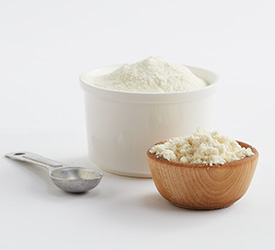Towards healthy ageing
US Dairy Export Council study explores protein, dairy, whey and perceptions around health and wellness.

Whey
Findings from a recent study commissioned by the US Dairy Export Council (USDEC) saw 98 percent of respondents in Thailand and Singapore aspire towards healthy ageing, but only half feel they are prepared for the process. The study, which explored topics of protein, dairy, whey and perceptions around health and wellness, focused on these two markets known for their diverse and different tastes and cultures.
At a webinar held F&B formulators and the nutrition community in Southeast Asia, nutrition and food innovation experts from Singapore and Japan discussed opportunities and proactive steps to narrow this large intention-action gap and reduce sarcopenia risks as Southeast Asia’s population ages. Sarcopenia is the age-related, progressive decline in muscle mass, strength and function that can impact adults as early as in their forties.
Addressing consumer knowledge gaps about the ideal sources of proteins nutritionally, along with the optimal quantity and timing to consume protein, is an important step to help consumers on a path to achieve their healthy ageing goals. While 80 percent of respondents in USDEC’s study agreed that protein is a key nutrient to build muscles, remain active and reduce muscle loss during ageing, many were confused about the body’s requirements for protein, how these needs change at different life stages, as well as the distinctive nutritional differences between plant, meat, and dairy proteins.
Dr Satoshi Fujita, professor, College of Sport and Health Science, Ritsumeikan University, Japan, shed scientific light on these questions. He explained the importance of sufficient protein intake spread evenly throughout the day with about 20g to 30g or 0.4g per kg of body weight at each meal – breakfast, lunch and dinner – to help protect against sarcopenia.
He also emphasised the importance of protein quality, especially the essential amino acid composition and the critically important role of the branched chain amino acid, leucine. When it comes to the ratio of essential amino acids as a percentage of total protein, whey proteins lead with 52 percent compared to other animal and plant sources such as beef (44 percent), cod (40 percent), soy (38 percent), pea (37 percent) and wheat (30 percent). Similarly, whey protein ranks highest for leucine content, the molecular trigger for muscle protein synthesis. Whey protein has a neutral flavour profile and can be incorporate into everyday foods, whether Western or Asian style.
Another issue speakers raised during the webinar was the imbalanced protein intake over the course of the day. In Southeast Asia where cuisines are carbohydrate-heavy, especially for breakfast, protein intake is low at the start of the day and high at the evening meal, rather than optimally spread evenly throughout the day. Incorporating dairy protein, especially at breakfast, is a proactive and convenient step consumers can take today to fill the protein gap at breakfast. This also helps preserve muscle mass and function to in turn, remain active in senior years.
“Incorporating ingredients such as whey and milk proteins into various rice and noodle dishes such as Pad Thai, laksa, fried rice, curries and desserts will help balance daily protein intake and in the case of the elderly, help them achieve their nutritional needs with familiar dishes,” said Pauline Chan, director, Food and Nutrition Specialists, Singapore.
From the study, consumers in both Thailand and Singapore indicated that they are willing to pay a premium for healthy food, actively read nutritional information prior to purchase and are keen on trying new flavours and variants. Eighty-three percent of all respondents also highlighted that they are likely to consume products with whey protein in the next 12 months.
“Consumers are increasingly aware of protein overall. However, our study shows that while demand is present in the region, the availability and variety of protein-enriched products is lagging behind. This presents a major opportunity for food and beverage manufacturers to capture a growing market in Southeast Asia through the introduction of protein-enriched variations of local dishes and products that consumers in the region are familiar with,” said Martin Teo, technical director – food applications, USDEC Southeast Asia.
(** PHOTO CREDIT: US Dairy Export Council)

0 Comments